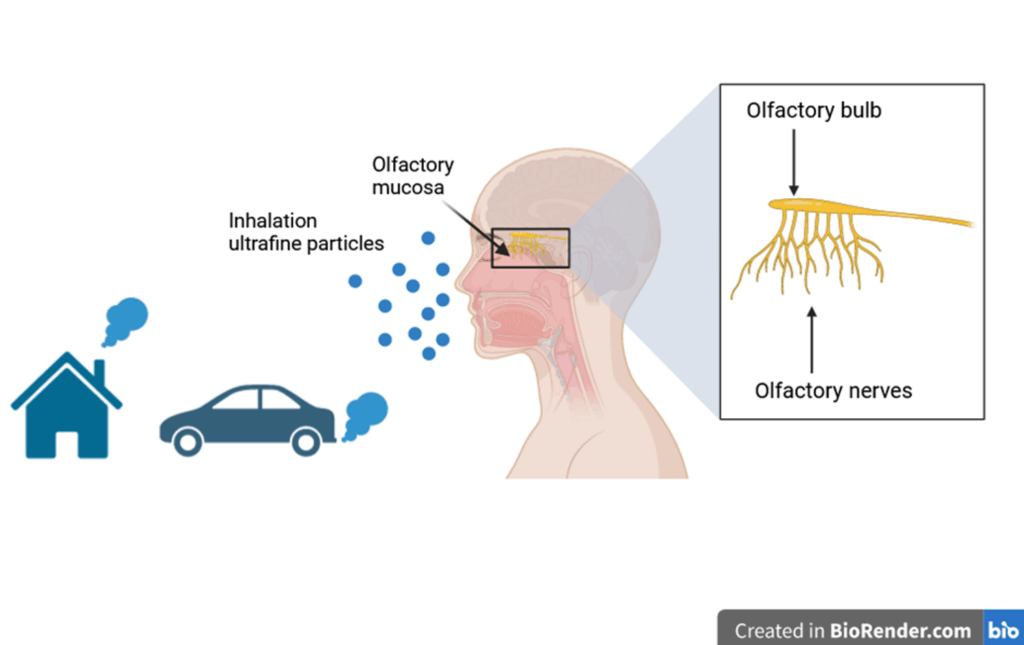28 Jul Blog | A Closer Look at Nanoparticle Deposition in the Lungs and Brain
by Eleftheria Chalvatzaki, Sofia Eirini Chatoutsidouand Mihalis Lazaridis (School of Chemical and Environmental Engineering, Technical University of Crete)
People are exposed to ultrafine particles every day. Traffic emissions from vehicle exhaust is a common source of ultrafine particles in urban environments. Exposure to airborne particles is linked with harmful effects on the human body, including a potential influence on the respiratory, cardiovascular, and central nervous systems. Ultrafine particles comprise the most harmful fraction of airborne particles because they can translocate to different organs and tissues such as the liver, spleen, kidneys, heart, serum, and placenta. They may also translocate to the brain through the systemic route (bloodstream) or via the olfactory pathway. The olfactory pathway is a viable route for the translocation into the brain and involves the transport of ultrafine particles, which are initially deposited in the nose, to olfactory mucosa and further translocation to the olfactory bulb (via the olfactory nerve).

The present research was performed within MI-TRAP. The goal was to estimate the deposition rate of ultrafine particles in the human respiratory tract and their translocation to the brain. Therefore, quantify the contribution from both pathways that affect brain deposition and may provide adverse health effects.
Exposure conditions
A young and healthy adult female (30 years old), which is a nose breather, was considered to rest in the outdoor environment and inhale ultrafine particles.
Research results
Research results showed that ultrafine particles deposition in the olfactory region was substantially lower (<1%) compared to the deposition in the respiratory tract (10 – 50 %).
When comparing the deposition among the 5 regions of the respiratory tract, higher depositions were obtained for the deepest part of the lungs (AI region) where alveoli are found. However, evaluation of the received dose per unit surface area and per cell suggested a significant burden in the olfactory region. This finding suggests the importance of evaluating other expressions for deposition and not strictly its rate to for determining more accurately the burden in the different parts of the human body, therefore the potential implications of ultrafine particles to human health.
Moreover, 4 common environmental conditions in urban areas were investigated:
- traffic hours
- periods with domestic heating emission
- formation of new particles in the air and
- background levels)
The analysis has shown that the amount of the dose received by the human respiratory tract depends on the metric used to quantify deposited particles. For example, when evaluating the dose expressed by the number of deposited particles higher dose corresponded to periods with formation of new particles. On the other hand, when evaluating the dose expressed by the mass of deposited particles higher dose was obtained during periods with heating emissions. All these findings can help us to further improve our understanding on how different pollution sources impact human health.
After clearance, similar dose levels were found between the extrathoracic region, the tracheobronchial region, alveoli, and oesophagus and slightly lower for blood. Nonetheless, a comparable dose was found between blood and the olfactory region. This is particularly important as these two cases comprise the two main transport routes for brain deposition.
Conclusions
The present research has shown that olfactory deposition of inhaled ultrafine particles comprises an important burden for the human body. Future evaluation of health effects due to exposure to ultrafine particle should consider implications arising from traditional such as blood and other routes such as the olfactory pathway. This may result to the development of better exposure – dose relationships for ultrafine particle which will have direct implications to human health risk assessment.
Further investigation is needed to better understand the health impacts arising from exposure to ultrafine particle, their translocation into the human body, and the input from population characteristics into deposition. The advantage of the present results is that quantification of the deposited dose in the respiratory tract and the olfactory region was performed by a single model, therefore results are directly comparable. Nevertheless, additional research is necessary for detailed estimations of particle deposition into the brain as well as future studies could involve male recipients.

Definitions
Nanoparticles are tiny particles having a size of a few nanometers and can be found suspended in the air. Ultrafine particles are nanoparticles that have a diameter up to 100 nm and are released in the ambient air by a variety of sources, most profoundly combustion processes (e.g. energy production, wildfires, domestic heating, vehicle exhaust).
Particle deposition Inhaled particles are absorbed by the human respiratory tract with a rate that depends on physiology of the human body, inhalation rate and concentration of particles. This process is called particle deposition and can be estimated by models developed explicitly for this reason.
The Human Respiratory Tract is the main route for airborne pollutants to enter the human body by inhalation. The Human Respiratory Tract is divided into 5 regions:
- the anterior nose region (ET1)
- the posterior nasal passages, pharynx and larynx region (ET2)
- the bronchial region (BB)
- the bronchiolar region (bb)
- the alveolar-interstitial region (AI)


